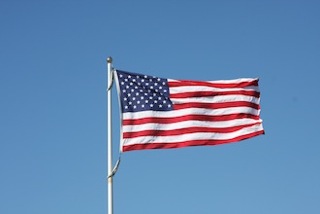Do You Know Proper Flag Etiquette? Time to Learn the Basics Now that Memorial Day Is Upon Us

By Staff
May 25, 2016: Three official holidays involving the American flag are coming up, all within the next six weeks: Memorial Day (May 30), Flag Day (June 14), and Independence Day (July 4). It is therefore time to brush up on your knowledge of flag protocol.
The United States Code sets forth laws relating to the flag of the United States; these laws are collectively referred to as the "Flag Code." The text of most of the Flag Code can be found at 4 USC Chapter 1, The Flag, at http://uscode.house.gov/download/pls/04C1.txt. The information, and in some cases the text itself, below is taken from section 8 of this chapter, "Respect for Flag"; section 6, "Time and Occasions for Display"; and section 7, "Position and Manner of Display."
Respect for Flag
Below is a list of dos and don'ts as set forth in the Flag Code in a section titled "Respect for Flag":
• No disrespect should be shown to the flag of the United States of America; the flag should not be dipped to any person or thing.
• Regimental colors, state flags, and organization or institutional flags are to be dipped as a mark of honor.
• The flag should never be displayed with the union down, except as a signal of dire distress in instances of extreme danger to life or property.
• The flag should never touch anything beneath it, such as the ground, the floor, water, or merchandise.
• The flag should never be carried flat or horizontally, but always aloft and free.
• The flag should never be used as wearing apparel, bedding, or drapery.
• It should never be festooned, drawn back, nor up, in folds, but always allowed to fall free.
• Bunting of blue, white, and red, always arranged with the blue above, the white in the middle, and the red below, should be used for covering a speaker's desk, draping the front of the platform, and for decoration in general.
• The flag should never be fastened, displayed, used, or stored in such a manner as to permit it to be easily torn, soiled, or damaged in any way.
• The flag should never be used as a covering for a ceiling.
• The flag should never have placed upon it, nor on any part of it, nor attached to it any mark, insignia, letter, word, figure, design, picture, or drawing of any nature.
• The flag should never be used as a receptacle for receiving, holding, carrying, or delivering anything.
• The flag should never be used for advertising purposes in any manner whatsoever.
• It should not be embroidered on such articles as cushions or handkerchiefs and the like, printed or otherwise impressed on paper napkins or boxes or anything that is designed for temporary use and discard.
• Advertising signs should not be fastened to a staff or halyard from which the flag is flown.
• No part of the flag should ever be used as a costume or athletic uniform. However, a flag patch may be affixed to the uniform of military personnel, firemen, policemen, and members of patriotic organizations.
• The flag represents a living country and is itself considered a living thing. Therefore, the lapel flag pin being a replica, should be worn on the left lapel near the heart.
• The flag, when it is in such condition that it is no longer a fitting emblem for display, should be destroyed in a dignified way, preferably by burning.
Time and Occasions for Display
What Time of Day: Although it is the "universal custom" to display the flag from sunrise to sunset, the Flag Code provides, in the section titled "Time and occasions for display," that "when a patriotic effect is desired, the flag may be displayed 24 hours a day if properly illuminated during the hours of darkness."
Manner of Raising and Lowering the Flag: The proper way to raise and lower the flag is that it "should be hoisted briskly and lowered ceremoniously."
Not During Foul Weather: The flag "should not be displayed on days when the weather is inclement, except when an all-weather flag is displayed."
Which Days: The Flag Code states that "the flag should be displayed on all days, especially on"
- New Year's Day
- Inauguration Day
- Martin Luther King, Jr.'s Birthday
- Lincoln's Birthday
- Washington's Birthday
- Easter Sunday
- Mother's Day
- Armed Forces Day
- Memorial Day (half-staff until noon)
- Flag Day
- Father's Day
- Independence Day
- National Korean War Veterans Armistice Day
- Labor Day
- Constitution Day
- Columbus Day
- Navy Day
- Veteran's Day
- Thanksgiving Day
- Christmas Day
- such other days as may be proclaimed by the president
- the birthdays of states
- state holidays
Public Institutions, Polling Places, and Schools: The flag should be displayed "daily on or near the main administration building of every public institution ... in or near every polling place on election days ... [and] during school days in or near every schoolhouse."
Position and Manner of Display
Processions: When carried in a procession in a line of other flags, the US flag should be in front of the center of that line, or when carried with a second flag, to the right of that flag. In general, the flag should not be displayed on a float in a parade except from a staff.
On Cars: "The flag should not be draped over the hood, top, sides, or back of a vehicle or of a train or boat." When displayed on a car, it "should be fixed firmly to the chassis or clamped to the right fender."
With Other Flags in General: "No other flag or pennant should be placed above or, if on the same level, to the right of the US flag" (special rules govern the placement of the US flag at church services at sea and the placement of the US the flag in relation to the flag of the UN).
With Other Flags Against a Wall from Crossed Staffs: When the US flag "is displayed with another flag against a wall from crossed staffs" (for example, in a courtroom or in a hall), "it should be on the right, the flag's own right [not the viewer's right], and its staff should be in front of the staff of the other flag."
With Flags of States, Cities, or Localities or with Pennants of Societies: "When flags of states, cities, or localities, or pennants of societies are flown on the same halyard with the flag of the United States, the latter should always be at the peak. When the flags are flown from adjacent staffs, the flag of the United States should be hoisted first and lowered last. No such flag or pennant may be placed above the flag of the United States or to the United States flag's right."
With Flags of Other Nations: "When flags of two or more nations are displayed, they are to be flown from separate staffs of the same height. The flags should be of approximately equal size. International usage forbids the display of the flag of one nation above that of another nation in time of peace."
Window Sills, Balconies, Fronts of Buildings: When the flag is displayed from a staff that is horizontal or at an angle from a window sill, balcony, or front of a building, the union should be at the peak of the staff (unless the flag is at half-staff).
On the Wall or in a Window: If the flag is hung horizontally or vertically on a wall or displayed in a window, the union should be at the top and "to the flag's own right, that is, to the observer's left."
Over a Street or Sidewalk: "When the flag is displayed over the middle of the street, it should be suspended vertically, with the union to the north in an east and west street and to the east in a north and south street." "When the flag is suspended over a sidewalk from a rope extending from a house to a pole at the edge of the sidewalk, the flag should be hoisted out, union first, from the building."
On a Speaker's Platform or from a Staff in a Church or Public Auditorium: "When used on a speaker's platform, the flag, if displayed flat, should be displayed above and behind the speaker. When displayed from a staff in a church or public auditorium, the flag ... should hold the position of superior prominence, in advance of the audience," and should be to the right of clergyman or speaker as he faces the audience.
At Unveiling of a Statue or Monument: "The flag should form a distinctive feature of the ceremony of unveiling a statue or monument, but it should never be used as the covering for the statue or monument."
Half-Mast: When flown at half-staff, the flag "should be first hoisted to the peak for an instant and then lowered to the half-staff position. The flag should again be raised to the peak before it is lowered for the day. On Memorial Day the flag should be displayed at half-staff until noon only, then raised to the top of the staff." Flags can be flown at half-staff for important government figures, governors of states, and foreign dignitaries by proclamation of the president of the United States. State governors may proclaim that the US flag be flown at half-staff to honor the death of a present or former official of the government of that state and to honor the death of a member of the armed forces from that state who dies while serving on active duty.
On Caskets: When the flag is used to cover a casket, the union should be at the head and over the left shoulder. The flag should not be lowered into the grave or allowed to touch the ground.
In Buildings: "When suspended across a corridor or lobby in a building with only one main entrance, [the flag] should be suspended vertically with the union of the flag to the observer's left upon entering" (more detailed rules for buildings with more than one main entrance).
Hanging the Flag Upside Down: To hang a country's flag upside down is an international distress signal. As noted above in the "Respect for Flag" section, the flag should never be displayed upside down except in "instances of extreme danger to life or property."
Additional information regarding the US flag and flag protocol can be found at www.ushistory.org.
Photo by A. Warner
Government & History Directory
Bronxville is a quaint village (one square mile) located just 16 miles north of midtown Manhattan (roughly 30 minutes on the train) and has a population of approximately 6,500. It is known as a premier community with an excellent public school (K-12) and easy access to Manhattan. Bronxville offers many amenities including an attractive business district, a hospital (Lawrence Hospital), public paddle and tennis courts, fine dining at local restaurants, two private country clubs and a community library.
While the earliest settlers of Bronxville date back to the first half of the 18th century, the history of the modern suburb of Bronxville began in 1890 when William Van Duzer Lawrence purchased a farm and commissioned the architect, William A. Bates, to design a planned community of houses for well-known artists and professionals that became a thriving art colony. This community, now called Lawrence Park, is listed on the National register of Historic Places and many of the homes still have artists’ studios. A neighborhood association within Lawrence Park called “The Hilltop Association” keeps this heritage alive with art shows and other events for neighbors.
Bronxville offers many charming neighborhoods as well as a variety of living options for residents including single family homes, town houses, cooperatives and condominiums. One of the chief benefits of living in “the village” is that your children can attend the Bronxville School.
The Bronxville postal zone (10708, known as “Bronxville PO”) includes the village of Bronxville as well as the Chester Heights section of Eastchester, parts of Tuckahoe and the Lawrence Park West, Cedar Knolls, Armour Villa and Longvale sections of Yonkers. Many of these areas have their own distinct character. For instance, the Armour Villa section has many historic homes and even has its own newsletter called “The Villa Voice” which reports on neighborhood news.
Link to Village of Bronxville One Square Mile Monthly Newsletter
Village of Bronxville Administrative Offices
337-6500
Open 9:00am - 4pm excluding holidays and weekends
Bronxville Police Department
337-0500
Open 24 hours
Bronxville Parking Violations
337-2024
Open 9:00am - 4pm excluding holidays and weekends
Bronxville Fire Deparment
793-6400
















